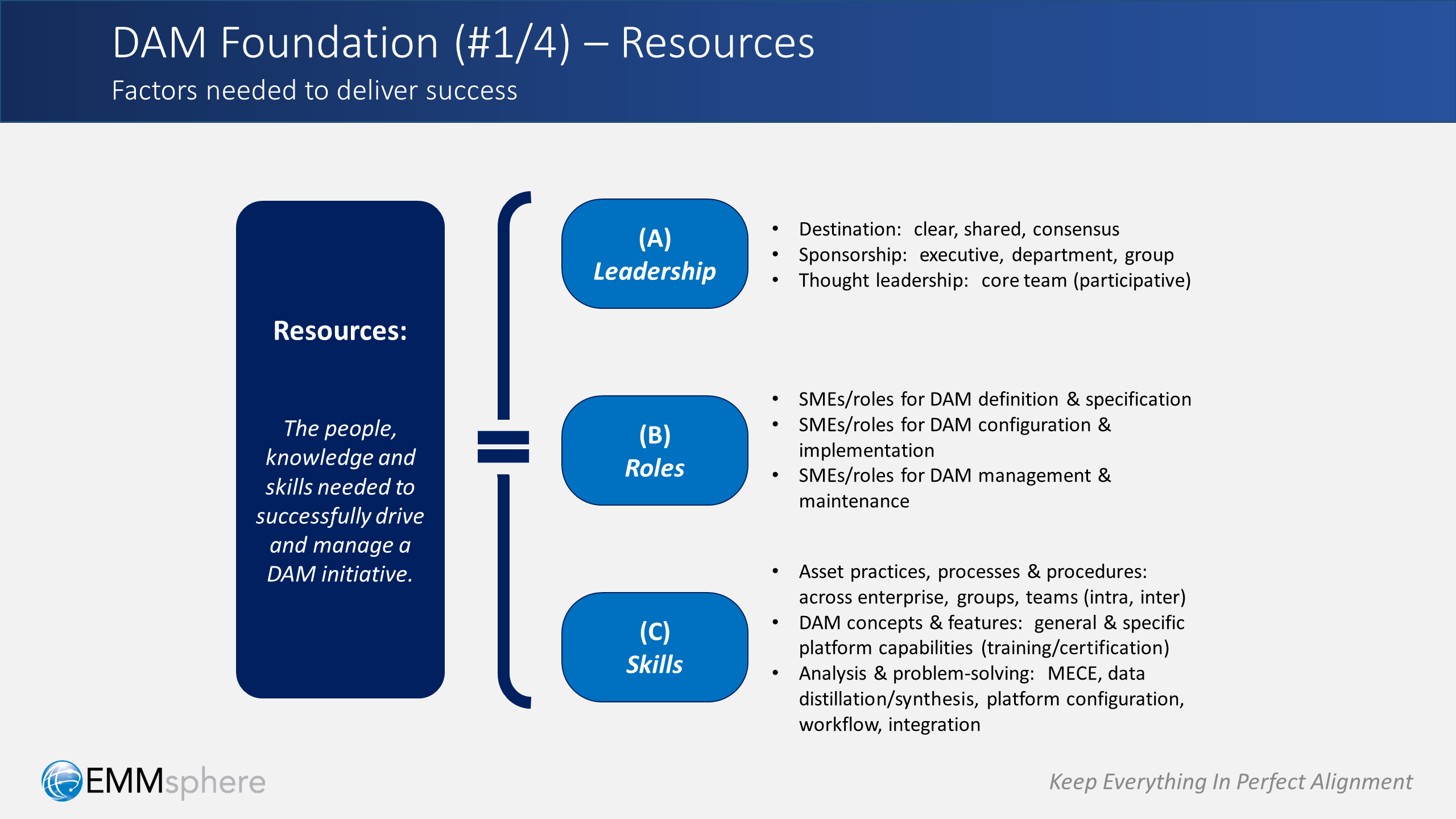
Setting the Stage for DAM Success
Now, when we talk about foundation, it’s not entirely a bad idea to remind ourselves of the old saying that the battle is won or lost before it’s ever fought. This statement is often true, which raises the stakes in getting the foundational pieces just right.
More importantly, what we – especially the core team – do early on can definitely set us on a trajectory toward the outcomes we’re targeting (building an Operational System of Record, and driving Adoption).
So let’s talk about the Foundation for DAM, which encompasses four dimensions: Resources, Specification, Process and Security.
DAM Foundation: Resources

The Resources dimension of Foundation is about the people, knowledge and skills needed to successfully drive and manage a DAM initiative.
This begins with Leadership: which means defining a clear destination for DAM, a shared vision with participation and consensus across teams, as well as establishing sponsorship at all levels.
Next, we need to ensure that the necessary Roles and subject matter experts are designated and assigned. The important part here is to allocate and deploy these roles early on, particularly in the case of administrators and librarians.
Which brings us to Skills: and we’ll admit, maybe we’re a little bias on this, but we can’t overstate the importance of ensuring that core team members have deep and broad skills in all things related to DAM.
DAM Foundation: Specification

Now let’s turn our attention to Specification, which is about the information needed for asset classification, definition, and administration.
Naturally, this means defining a comprehensive Taxonomy, that covers industry-relevant and enterprise-specific content types, with cross-departmental consolidation and consistency. And don’t forget work-in-progress or restricted areas for agencies, confidential materials, etc.
Of course, we’ll need to have our Metadata fully defined, including production, descriptive and technical information about each asset.
And, we’ll need to specify the Administrative aspects of our information: usage and licensing rights, along with brand, compliance and regulatory requirements.
And one more thing: let’s not forget to specify where all this information comes from. Remember, not all metadata is embedded in the file itself. Much of it comes from outside sources, and needs to incorporated using sidecar uploading, AI auto-tagging, etc.
DAM Foundation: Process

The next dimension of our DAM foundation is Process, which is the definition of key sequences of activity across the overall asset lifecycle that will be executed with respect to DAM.
The first thing we need to do is specify all of our Use Cases: these will describe how our various target audiences interact with the DAM, and how assets will be used across their entire lifecycle.
Next we define Procedures: here, we start by formalizing detailed process definitions for our various use cases, and we augment that by specifying the review and control gates that will ensure asset compliance at key points in their lifecycle. We also assign accountability to specific roles.
Last, we define the Measurements we want to track for our DAM, and the corresponding performance and exception reports we want to generate and monitor over time.
DAM Foundation: Security

The fourth and last dimension of Foundation is Security, which is about the capability- and data-related functions that will be controlled and managed within the DAM system.
This means Permissions: which relate to the definition of users, groups and roles and the corresponding functional privileges, and settings, assigned to each.
It also specifies Access levels: which relate to the taxonomy-, asset- and data-level access that will be granted to specific users, groups and roles.
And finally, it covers Presentation: which defines how assets and data are conditionally presented in the UI to specific users, groups and roles, as well as how parts of the overall navigation and menu actions are granted.
One more thing to keep in mind: security is something that often gets addressed later in a deployment cycle, but we think we should define it as soon as possible. The reason is that Security will be critical to our success in managing the presentation of DAM information to target audiences, as presentation is often conditional on security and access levels.
Closing Thoughts
As we mentioned earlier, the core team will be instrumental in defining and setting up a robust foundation for the DAM – all four foundational dimensions are key factors for the success of our core team.
But frankly, all four of these foundational dimensions are ultimately key factors for the success of all target audiences. It’s certainly worth the while to go the extra mile when defining your DAM’s foundation – the foundation is one area where there really is no such thing as over-delivering!
Next Steps
“DAM Perspectives” is a series of posts that came from the work we did to develop a new DAM maturity framework. So, as a next step, we invite you to check out some of the other posts in this series:
- DAM Perspectives (Part 1): The Need for a New Approach
- DAM Perspectives (Part 2): The Two Key Outcomes
- DAM Perspectives (Part 3): The Target Audiences
- DAM Perspectives (Part 4): Building the Foundation
- DAM Perspectives (Part 5): Building the Solution
- DAM Perspectives (Part 6): Building Conformity
Leave a Reply